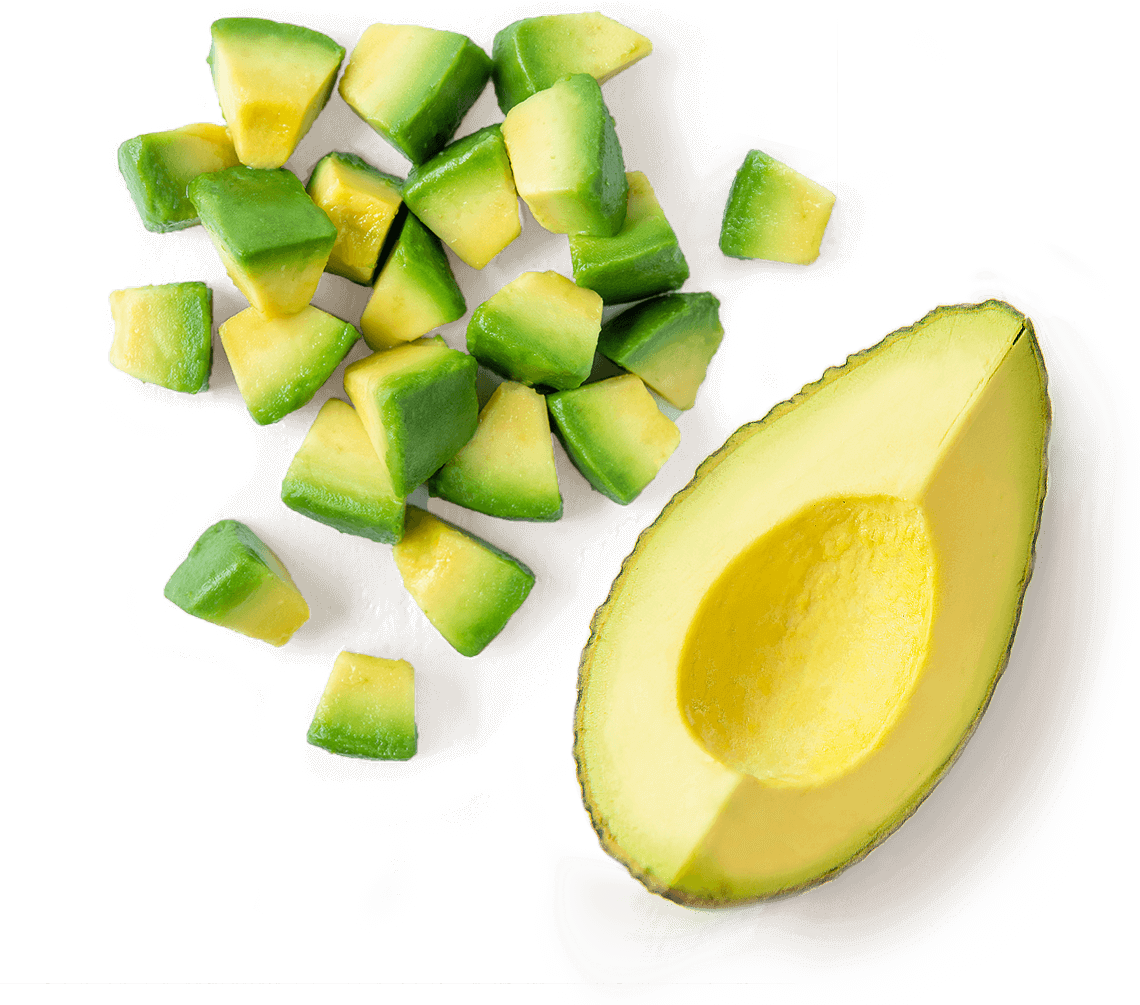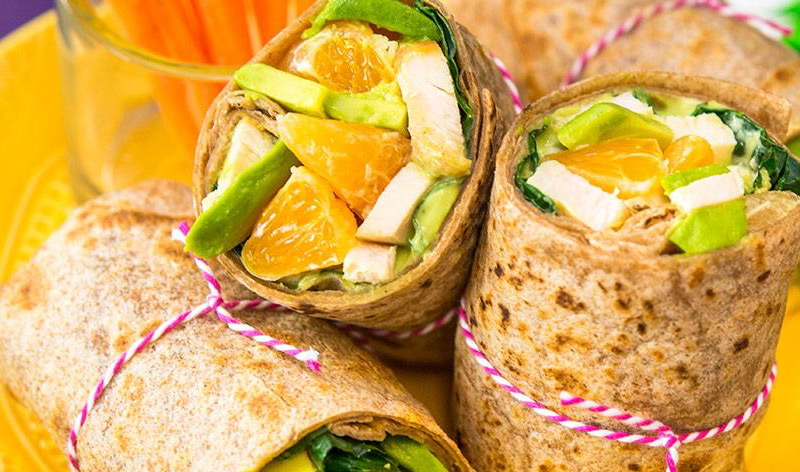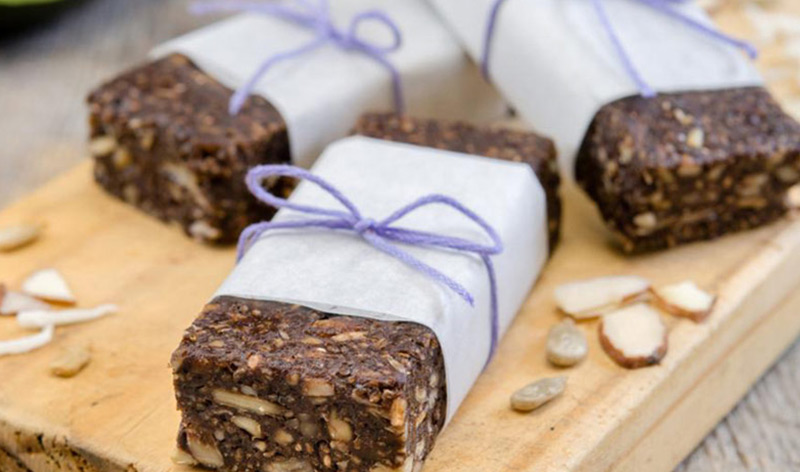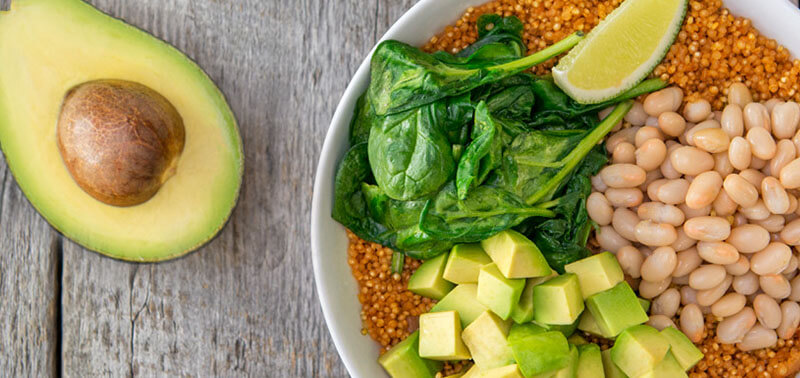Swapping ultra-processed snacks for healthy alternatives is easier when you focus on simple, whole foods like fruits, vegetables, and healthy fats. Avocados offer a creamy, kid-friendly texture that works well in sweet and savory snacks. For toddlers, a 25 g serving has 2 g of fiber, 3 g of unsaturated fats, 125 mg of potassium, and 20 mcg DFE of folate, which can support energy, satiety, and child development. As for school-aged children, a 50 g serving has 3 g of fiber, 5 g of unsaturated fats, 250 mg of potassium, and 45 mcg DFE of folate.
Nutritious avocado snack alternatives include:
- Avocado toast topped with cottage cheese or eggs
- Smoothies made with avocado, banana, spinach, and Greek yogurt
- Jicama sticks with guacamole
- Mini chicken-avocado sandwiches in fun shapes
- Homemade granola bars with avocado and dark chocolate
- Avocado chocolate almond oat bites for a sweet, nutrient-dense treat
Smart snacking tips for families:
- Offer snacks 2–3 times daily between meals
- Prep snacks ahead and store them at the kids’ eye level
- Balance fiber and protein (e.g., avocado + yogurt)
- Encourage repeated exposure to new snacks to overcome picky eating
- Get kids involved in snack prep to build interest and acceptance
Switching from processed to nutritious snacks becomes easier with planning, creativity, and consistency, especially when avocados are on the menu.
Snack Healthy:
Replacing Processed Snacks With Avocado-Based Recipes
Finding healthy snacks that kids actually enjoy—and adults won’t mind finishing off—can be surprisingly tricky. Many kids like processed snacks because they’re reliable. They don’t have to worry about the texture of potato chips, for example, because they’ve been manufactured to be the same every single time you open the bag. They’re also convenient for parents without worrying about prepping and cleaning up afterward. However, processed snacks often feature ingredients that don’t support long-term health and are largely devoid of nutritional value.
For parents and caregivers striving to nourish their families, the search for wholesome, yet convenient snacks often feel like a daily challenge.
Enter the avocado: a versatile fruit that’s naturally creamy, sugar-free, and adaptable to various tastes. Whether catering to toddlers, school-aged kids, teens, or picky eaters, avocado-based snacks offer an innovative and delicious alternative that aligns with diverse dietary needs and preferences.
Why Ultra-Processed Snacks Fall Short
The primary reason ultra-processed foods may not be the best choice for family snacks is because of the nutritional red flags, including:
- Added sugars
- Excess sodium
- Artificial preservatives
All these additives enhance the flavor of snacks. They make the snacks hyperpalatable — a classification of foods that can be so tasty that it’s often difficult to stop at just one serving because of the dopamine rush you receive. As a result, you’re more likely to ignore fullness and hunger cues, experience a sudden burst of energy, quickly followed by a crash, leaving you feeling hungry shortly afterward.
Some examples of ultra-processed snacks include:
- Chips
- Candy
- Sugary cereal
- Fried foods
Ultra-processed snacks mostly lack fiber, protein, and other essential nutrients. Fiber and protein, in particular, can help regulate your appetite. Eating snacks without these nutrients makes you feel hungrier sooner, which may lead to a higher caloric intake. If you eat more processed snacks over whole, nutritionally dense snacks, you’re more likely to develop nutrient deficiencies, obesity, type 2 diabetes, or experience a stroke and heart attack.
The Avocado Advantage for Snacking for Little Kids
Snacks aren’t a terrible thing. In fact, snacks that include essential nutrients can benefit your family’s health. Healthy snacks are essential for kids to help them get the nutrients they need for proper growth and development.
The key is to look at which snacks they’re consuming. Grazing and random, unplanned snacks throughout the day can interfere with your child’s appetite and disrupt natural hunger at mealtime. Therefore, it is vital to have a healthier snack strategy for your toddler that makes every bite count, which is why avocados can be a great choice. Their nutritional makeup makes them an excellent snack for anyone in the family. In a 25 g serving, toddlers can enjoy:
- 3 g of unsaturated fats: Unsaturated fats, also known as “good fats,” can help manage cholesterol levels and overall heart health.
- 2 g of fiber: Fiber can improve satiety and gut health
- 125 mg of potassium: Potassium is key in muscle development and body growth, which kids need as they grow.
- 20 mcg DFE of folate: Folate is critical for infants and pregnant women when developing healthy new red blood cells and amino acids.

With their creamy texture and mild flavor, avocados can be more approachable than other fruits — even for picky eaters. Plus, they’re easy for parents to prepare, making snack time less of a hassle.


Smart Snacking Strategies for Busy Families
Inconvenience is one of the most significant barriers for families when providing healthy snacks. However, healthy snacking doesn’t have to be complicated. Following these simple strategies may help:

Stick to predictable snack times:
Plan two to three small snacks at set times. According to the Academy of Nutrition and Dietetics, a good rule of thumb is to offer snacks a few hours after one meal ends and about one to two hours before the next meal begins.

Balance fiber and protein for satiety:
Choose snacks that contain protein and fiber that can be filling and sustaining, such as low-fat yogurt with fruit, a small cheese quesadilla with guacamole, or sliced apples with almond butter.

Cook at home:
Homemade snacks give you more control over ingredients, making it easier to skip the preservatives and tailor recipes to your family’s tastes and nutritional needs.

Make snacks accessible:
Keep healthy options at kids’ eye level in the fridge or pantry. Use clear containers and easy-open packaging to encourage independent, nutritious choices.

Prep ahead:
Prep healthy snacks in advance to save you time later. Store them in accessible containers so kids can grab them when hunger strikes.

Hydrate:
Sometimes thirst disguises itself as hunger. Encourage kids to drink water regularly to stay hydrated and reduce unnecessary snacking.

Use snack time to try new foods:
Be sure to expose your kids to different foods during snack time to help build taste preferences and prevent picky eating. Some will need up to 8 to 10 exposures before they accept a new food. Always consult your healthcare provider before introducing any new food.

Provide nutrient-dense foods:
Use snack time to fill the nutrient gaps. Offer a variety of nutrient-dense fruits, vegetables, grains, protein foods, dairy, and fortified soy alternatives. For example, your child may refuse green vegetables at mealtime but will gladly accept fresh avocado for a snack. Kid-friendly avocados provide great taste and a fun texture, contributing to their daily intake of valuable nutrients.
Making healthier snack choices can be simple with these tips—and better choices today can mean better health for your whole family.
From Lunchboxes to After-School: Snacks for Your School-Aged Children
The key to consistently making and providing non-processed snacks is to make a habit. Healthy habits grow with time and intention—and the best part is, you don’t have to get it right every time. Progress matters more than perfection.
Grocery Planning for Avocado-Based Snacks
1. Make a shopping list:
What meals are you planning to prepare? Brainstorm a few ideas, such as rice with chicken and an avocado salad. Before heading to the store, list the items you need. For the snack ideas shared above, you will need chicken, carrots, green beans, onions, cassava, corn on the cob, plantains, etc. This will help you stay focused and avoid impulse purchases. Take advantage of coupons and store discounts.
2. Compare prices:
Be smart! Compare apples to apples. When shopping, compare price per unit and price per pound when comparing products.
3. Pick avocados at different ripening stages:
To keep avocados on hand all week, pick a mix of ripeness levels when you shop. Choose some that feel firm to enjoy later in the week and a few that yield gently to pressure to use sooner. Store them at room temperature to let them ripen naturally, and once they’re ready, you can pop them in the fridge to keep them fresh a little longer.
Once you get home, you can start the fun part — preparation!
Get the Kids Involved
Kids can be notorious picky eaters, but if they’re involved in preparation, they may be more emotionally invested in the outcome of the snack. It can be more than just snack time — it can be a culinary experience. For example, you can let your kids choose toppings for avocado toast, mash the avocado, or decide what they want in their smoothie. This can help give them the independence to choose what they want while sticking to whole, unprocessed snacks. Let children choose toppings, dip pairings, or smoothie ingredients.
Reinforce Food Acceptance Through Repetition
Kids may need a little time to warm up to homemade snacks, and that’s okay—keep offering them in fun and tasty ways. According to a systematic review published in 2019, there is substantial evidence that kids were more likely to accept new fruits and vegetables if they at least tasted them once a day for 10 days. Kids like reliability and consistency.
Because healthy habits don’t start with rules — they start with role models.
Providing nutritious and exciting snacks for your children doesn’t have to be a daunting task. By following these tips and utilizing the creative recipes on Love One Today, you can ensure your kids stay energized and focused throughout the day.











